Today I would like to talk to you about some good news, that has occurred in Spain: “Some Spanish scientists have discovered that strawberry seeds contain 81% of antioxidants”.
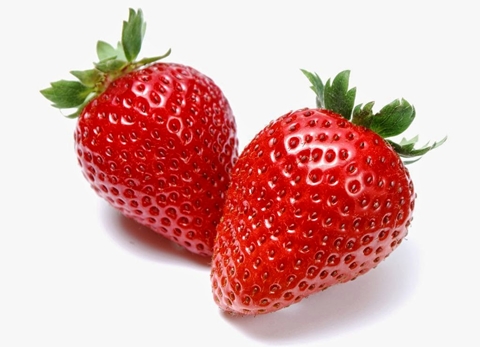
Strawberry pips contain the most antioxidants of this fruit, 81% of the total, as demonstrated by researchers at the Research Institute for Agricultural and Fisheries Training (IFAPA) of the Government of Andalusia, in collaboration with the Universities of Vigo (Galice, northern Spain) and Marche (Italy).
Scientists have reached these results through a simulation process of digestion, performed in the laboratory, what has allowed them to quantify the antioxidants of strawberries, that are released in the stomach and intestine, as the Discover Foundation has informed, in a statement.
The pips are 7.5% of the dry weight of this fruit, "therefore, it is even more striking that, despite its size, the pips contain the antioxidant power", as has explained the researcher, Maria Teresa Ariza, from the area of Genomics and Biotechnology, at the Ifapa.
The researchers have conducted "a bioavailability study to check the components, that these products emerge in the stomach and, on the other hand, bioavailability, to learn which of these may pass into the bloodstream", Ariza has indicated; antioxidant compounds, analysed in this work, have mainly been phenols, flavonoids and anthocyanins.
The methodology used, to reach these conclusions, published in the International Journal of Molecular Sciences, under the title “The Achenes of strawberries are an important source of bioactive compounds for human health”, it refers to the process of simulation, in vitro digestion.
This consists in introducing, into a glass beaker, a certain amount of strawberries and pips with water, to, from there, with a probe, measure the pH or acidity and decrease, at a figure of 1.8, which is the same as it has a normal empty stomach; to this mixture, is added pepsin, the enzyme responsible for digesting food.
The composition is maintained for two hours and from it is extracted a small portion of liquid, called gastric fraction, which is the one analysed and where the antioxidant compounds, detached from the achene and strawberry, are observed. The same procedure is performed, in the simulation of intestinal digestion, which is performed in the intestine.
This methodology has allowed to determine that the pips, after gastric digestion, release a higher proportion of antioxidants than the pulp or red part of strawberry.
The Strawberry is one of the fruits lowest in calories, it is also diuretic and very rich in fiber; so it helps the intestinal transit. Thanks to these characteristics, it is the best ally to reduce a little gut. It is an excellent source of vitamin C, beta carotene and vitamin E, the three main antioxidants. The consumption of this spring fruit is especially recommended in diets to prevent cardiovascular diseases, cancer, arthritis, gout and anemia. And as if that weren’t enough, it has an acid (ellagic), that neutralizes the most negative effects of tobacco. Among the minerals, that it possesses, are calcium, iodine, phosphorus, magnesium, iron and potassium. It also contains folic acid and, in the natural medicine, it is used to clean and purify the digestive system.
It is also known that strawberries juice has antibacterial properties, because of the presence of carotenes, and they are perfect to complete the diet of people who do not eat meat, because the vitamin C, that they contain, helps the absorption of iron.
The consumption of strawberries is not recommended in patients with kidney disease, diabetes and other gastrointestinal disorders (gastritis, delicate stomach ...).
I take this opportunity to talk to you about the "Strawberries of Huelva" (Costa de la Luz, Southwest Spain).
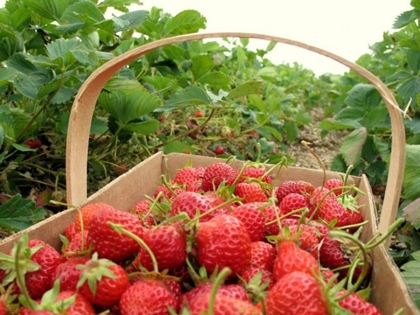
The strawberries of Huelva are the third most exported product from Spain.
The strawberries of Huelva have joined the list of ambassadors of the candidacy to the gastronomic capital of Huelva, for the next year 2017.
Up to 30 companies produce strawberries, in Huelva, distributed by the villages of: Palos de la Frontera, Moguer, Bollullos del Condado, Lepe, San Bartolomé de la Torre and Isla Cristina.
The company Masiá Ciscar, S.A., located in the village of Lepe, began producing strawberries in the 70s.
This company produces and commercialises strawberries through the company S.A.T. Las Palmeritas.
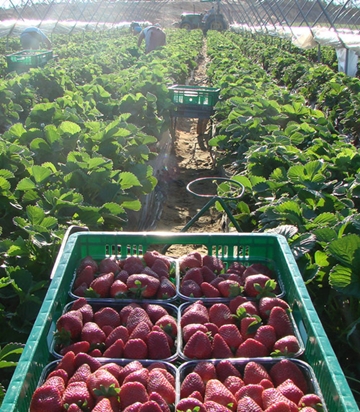
Farm crop of Masiá Ciscar, S.A.
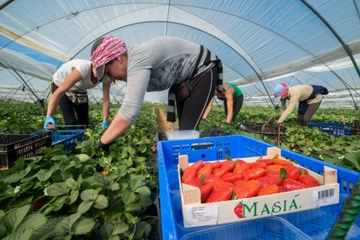
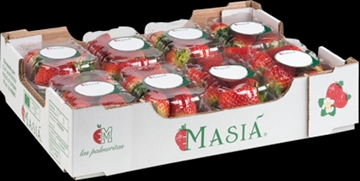
Specifically, they commercialise two varieties of large strawberry: Primoris and Sabrina.
In Masiá Ciscar, they analyse, on the one hand, if the varieties, which are currently planted, can be substituted for others, that clearly improve what there is already; and, on the other hand, it is also studied whether a new segment of the market, which is not satisfied with the cultivated material, can be supplemented with some variety in trial.
Likewise, to produce a varietal change, in the company, it requires a minimum of three years. This period comprises the time elapsing between the test of the test of the own field test and its production, at commercial level and large scale.
On the other hand, Masiá Ciscar S.A. collaborates with other improvement programs in strawberries in Huelva, evaluating advanced selections of them, in order to get the best product for consumers. These advanced selections are in a second test field.
To these advanced selections, which can range from 20 to 30 a year, are evaluated for quality (colour, Brix grades (Brix grades serve to determine the total quotient of dry matter (usually sugars) dissolved in a liquid), post harvest and hardness), precocity, production and, subsequently, multiplication in nursery. Of all of them, only a maximum of three (the best three) make the cut and, the following year, they are evaluated, with greater quantity, in the test field.
Well, I hope that you have liked to know about strawberries and specifically about strawberries of Huelva.
Until my net post, kind regards,
Luis.
Sponsored by Costaluz Lawyers.
Please click below:
